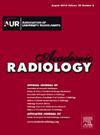Revisiting the Clinical Interpretation of CT-Measured Pulmonary Artery-to-Aorta Ratio—The Rotterdam Study
IF 3.8
2区 医学
Q1 RADIOLOGY, NUCLEAR MEDICINE & MEDICAL IMAGING
引用次数: 0
Abstract
Rationale
The pulmonary artery (PA) diameter-to-aorta ratio (PA:A) ratio is a novel marker in cardiovascular imaging for detecting pulmonary hypertension. However, we question the effect of the varying aorta diameter on the ratio, which complicates the interpretation of the PA:A ratio.
Objective
Investigate the variability of the PA:A ratio by examining the correlation between PA:A ratio and aorta diameter and by comparing the associations of the PA diameter, aorta diameters, and PA:A ratio.
Methods
We included 2197 participants from the Rotterdam Study who underwent non-contrast multidetector computed tomography to measure the PA and aorta diameters. Pearson correlation coefficient was calculated between the PA:A ratio and aorta diameter. Multiple linear regression analyses were performed to compare the determinants of the individual diameters and PA:A ratio.
Results
We found a statistically significant correlation between the PA:A ratio and aorta diameter (r = −0.38, p < 0.001). The PA diameter was statistically significantly associated with, height, weight, diastolic blood pressure, blood pressure medication, prevalence of atrial fibrillation, prevalence of heart failure, and prevalence of stroke (p < 0.05). Except for blood pressure medication, the PA:A ratio had similar determinants compared to the PA diameter but was also statistically significantly associated with sex, and systolic blood pressure (p < 0.05), which were statistically significantly associated with the aorta diameter (p < 0.05).
Conclusion
The PA:A ratio should not be interpreted without taking into account the variability of the individual components (PA and aorta diameter) according to the anthropomorphic and clinical characteristics.
重新审视 CT 测量的肺动脉与主动脉比率的临床解释--鹿特丹研究。
理论依据肺动脉(PA)直径与主动脉比值(PA:A)是心血管成像中检测肺动脉高压的新标记。通过研究 PA:A 比值与主动脉直径之间的相关性,并比较 PA 直径、主动脉直径和 PA:A 比值之间的关联,我们对 PA:A 比值的可变性提出了质疑。方法我们纳入了鹿特丹研究中的 2197 名参与者,他们接受了非对比多载体计算机断层扫描,以测量 PA 和主动脉直径。计算了 PA:A 比值与主动脉直径之间的皮尔逊相关系数。结果我们发现 PA:A 比值与主动脉直径之间存在统计学意义上的显著相关性(r = -0.38,p <0.001)。PA 直径与身高、体重、舒张压、血压药物、心房颤动患病率、心力衰竭患病率和脑卒中患病率均有统计学意义(p < 0.05)。除血压药物外,PA:A 比值的决定因素与 PA 直径相似,但在统计学上与性别和收缩压显著相关(p < 0.05),而在统计学上与主动脉直径显著相关(p < 0.05)。
本文章由计算机程序翻译,如有差异,请以英文原文为准。
求助全文
约1分钟内获得全文
求助全文
来源期刊

Academic Radiology
医学-核医学
CiteScore
7.60
自引率
10.40%
发文量
432
审稿时长
18 days
期刊介绍:
Academic Radiology publishes original reports of clinical and laboratory investigations in diagnostic imaging, the diagnostic use of radioactive isotopes, computed tomography, positron emission tomography, magnetic resonance imaging, ultrasound, digital subtraction angiography, image-guided interventions and related techniques. It also includes brief technical reports describing original observations, techniques, and instrumental developments; state-of-the-art reports on clinical issues, new technology and other topics of current medical importance; meta-analyses; scientific studies and opinions on radiologic education; and letters to the Editor.
 求助内容:
求助内容: 应助结果提醒方式:
应助结果提醒方式:


